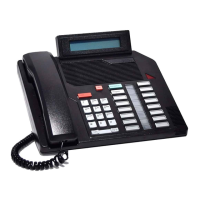3-2 DPP Software
297-1001-019 Standard 02.01 April 1997
The basic boot programs search the disk for the larger programs, such as the
application routines, and cause them to download to the DPP RAM. If good
program/data cannot be found on disk, the boot program requests a program
load from the DMS-100 through the DMS-100 to DPP human-machine
interface links. The boot program is stored in EPROM to ensure that it is
always available to the DPP microprocessors.
System start-up and scheduler
Once the additional programs are loaded, there are a number of other features
used by the system. The DPP operating system includes several code
modules that both supervise and offer services to various application
processes. This structure is distinguished by its separation of function,
combined with a strong intercoupling of function modules. The DPP start-up
and scheduler consists of six modules:
• Process Scheduler
• Clock Services
• System Calls
• Memory Manager
• General Purpose Functions
• Human-machine interface functions.
Once the additional programs are loaded, there are a number of other features
used by the system. Scheduler routines control the activities of the
microprocessor and the clock circuits. Memory management modules assign
RAM areas to incoming data, temporary storage, vector tables, device status,
and other data structures, as required. File system routines direct the flow of
data to and from the disk. Error control functions, log and alarm messages,
command responses, and emergency access modules are part of the system
monitor.
System utility routines allow access to the memory, permitting examination
of the Disk/SCSI interface, and processor files. The DMS-100 displays the
contents of these areas at the MAP for viewing by the craftsperson. The
utility routines also allow user programming to facilitate selection of features.
For example, menu choices, AMA or status report requests, or maintenance
and test procedures. Communications with the DMS-100 go through the
MAP application software to reach the lower monitor routines.
Application routines
System instructions that are related to data handling or DPP features are
referred to as application routines. Software modules falling under the
application classification are generally higher level programs since more
complicated decisions and data manipulations are encountered here than are
12

